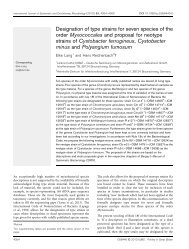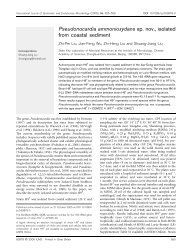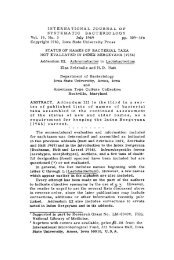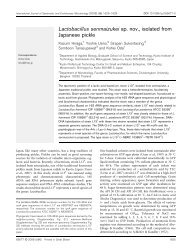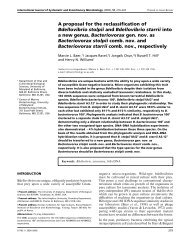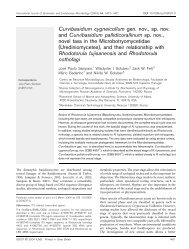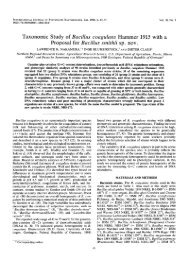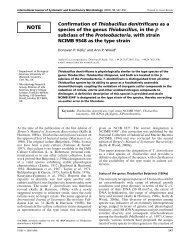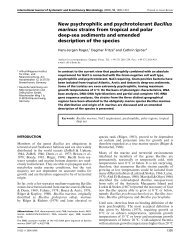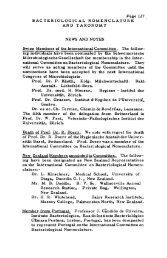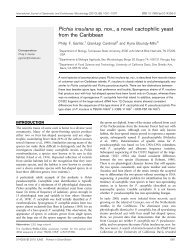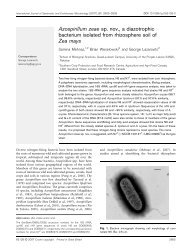(Lewin 1969) Leadbetter 1974 and 'Microscilla sericea'
(Lewin 1969) Leadbetter 1974 and 'Microscilla sericea'
(Lewin 1969) Leadbetter 1974 and 'Microscilla sericea'
You also want an ePaper? Increase the reach of your titles
YUMPU automatically turns print PDFs into web optimized ePapers that Google loves.
International Journal of Systematic <strong>and</strong> Evolutionary Microbiology (2010), 60, 1858–1863 DOI 10.1099/ijs.0.016121-0<br />
Correspondence<br />
Olga I. Nedashkovskaya<br />
olganedashkovska@piboc.dvo.ru<br />
or<br />
olganedashkovska@yahoo.com<br />
Detailed analysis of the phylogenetic relationship between<br />
members of the genera Flexibacter, Flexithrix <strong>and</strong> Microscilla<br />
based on the comparison of 16S rRNA gene sequences has<br />
revealed their considerable heterogeneity (Nakagawa et al.,<br />
2002). These authors suggested restricting the genera<br />
Flexibacter <strong>and</strong> Microscilla to their respective type species,<br />
Flexibacter flexilis <strong>and</strong> Microscilla marina, while the other<br />
species previously allocated to these genera were considered<br />
potential members of novel species <strong>and</strong> genera or families.<br />
The name [Flexibacter] aggregans attributed to strain IAM<br />
14894 T (5IFO 15976 T ) was recognized as a later heterotypic<br />
synonym of Flexithrix dorotheae, <strong>and</strong>‘[Microscilla] furvescens’<br />
LMG 13023 T was reclassified in the novel genus Marinoscillum<br />
as Marinoscillum furvescens comb.nov.(Hosoya&Yokota,<br />
2007; Seo et al., 2009). The genera Flammeovirga <strong>and</strong><br />
Persicobacter were created due to reclassification of the species<br />
Cytophaga aprica <strong>and</strong> Cytophaga diffluens, respectively<br />
(Nakagawa et al., 1997).Taxonomicinvestigationsofnewly<br />
isolated marine bacteria served as a basis for emending the<br />
descriptions of these genera (Muramatsu et al., 2010;<br />
Takahashi et al., 2006). Moreover, the related genera<br />
Reclassification of Flexibacter tractuosus (<strong>Lewin</strong><br />
<strong>1969</strong>) <strong>Leadbetter</strong> <strong>1974</strong> <strong>and</strong> ‘Microscilla sericea’<br />
<strong>Lewin</strong> <strong>1969</strong> in the genus Marivirga gen. nov. as<br />
Marivirga tractuosa comb. nov. <strong>and</strong> Marivirga<br />
sericea nom. rev., comb. nov.<br />
Olga I. Nedashkovskaya, 1 Marc Vancanneyt, 2 Seung Bum Kim 3<br />
<strong>and</strong> Kyung Sook Bae 4<br />
1 Pacific Institute of Bioorganic Chemistry of the Far-Eastern Branch of the Russian Academy of<br />
Sciences, Pr. 100 Let Vladivostoku 159, 690022 Vladivostok, Russia<br />
2 BCCM/LMG Bacteria Collection, <strong>and</strong> Laboratory of Microbiology, Ghent University,<br />
Ledeganckstraat 35, B-9000 Ghent, Belgium<br />
3<br />
Department of Microbiology, Chungnam National University, 220 Gung-dong, Yusong,<br />
Daejon 305-764, Republic of Korea<br />
4<br />
Korea Research Institute of Bioscience <strong>and</strong> Biotechnology, 52 Oun-dong, Yusong,<br />
Daejon 305-333, Republic of Korea<br />
The taxonomic position of the misclassified strains [Flexibacter] tractuosus KCTC 2958 T <strong>and</strong><br />
‘[Microscilla] sericea’ LMG 13021 was studied using a polyphasic approach. The two strains<br />
shared 99.1 % 16S rRNA gene sequence similarity <strong>and</strong> 28 % DNA–DNA relatedness. On the<br />
basis of the phylogenetic evidence supported by genotypic <strong>and</strong> phenotypic data [Flexibacter]<br />
tractuosus KCTC 2958 T <strong>and</strong> ‘[Microscilla] sericea’ LMG 13021 are classified as two distinct<br />
species in a novel genus, Marivirga, in the family ‘Flammeovirgaceae’, as Marivirga tractuosa<br />
comb. nov. <strong>and</strong> Marivirga sericea nom. rev., comb. nov., with strains KCTC 2958 T (5ATCC<br />
23168 T 5CIP 106410 T 5DSM 4126 T 5NBRC 15989 T 5NCIMB 1408 T 5VKM B-1430 T ) <strong>and</strong><br />
LMG 13021 T (5ATCC 23182 T 5NBRC 15983 T 5NCIMB 1403 T ), respectively, as the type<br />
strains. The type species is Marivirga tractuosa.<br />
Fabibacter, Fulvivirga, Limibacter, Perexilibacter, Rapidithrix,<br />
Reichenbachiella, Roseivirga <strong>and</strong> Sediminitomix were described<br />
over the past few years due to extensive taxonomic studies<br />
(Khan et al., 2007; Lau et al., 2006; Nedashkovskaya et al.,<br />
2003, 2005a, b, 2007; Srisukchayakul et al., 2007; Yoon et al.,<br />
2007, 2008). The above-mentioned genera have recently been<br />
grouped in the family ‘Flammeovirgaceae’ (Ludwig et al., 2008;<br />
Yoon et al., 2007, 2008).<br />
‘[Microscilla] tractuosa’ KCTC 2958 <strong>and</strong> ‘[Microscilla]<br />
sericea’ LMG 13021 were first described by <strong>Lewin</strong> (<strong>1969</strong>).<br />
<strong>Leadbetter</strong> (<strong>1974</strong>) transferred ‘[Microscilla] tractuosa’ to the<br />
genus Flexibacter but Reichenbach (1989) restricted this<br />
genus to the freshwater <strong>and</strong> terrestrial species, while its<br />
marine representatives were maintained in the genus<br />
Microscilla. [Flexibacter] tractuosus was included in the<br />
Approved Lists of Bacterial Names (Skerman et al., 1980)<br />
but ‘[Microscilla] sericea’ was not.<br />
The taxonomic investigation performed in this study on<br />
[Flexibacter] tractuosus KCTC 2958 T <strong>and</strong> ‘[Microscilla]<br />
sericea’ LMG 13021 T by using a polyphasic approach<br />
1858 016121 G 2010 IUMS Printed in Great Britain
showed that the strains should be placed in a novel genus<br />
as two distinct species, for which the names Marivirga<br />
tractuosa comb. nov. <strong>and</strong> Marivirga sericea nom. rev.,<br />
comb. nov. are proposed.<br />
[Flexibacter] tractuosus KCTC 2958 T <strong>and</strong> ‘[Microscilla]<br />
sericea’ LMG 13021 were routinely cultivated at 28 uC on<br />
marine agar 2216 (MA; Difco) <strong>and</strong> stored at –806C in<br />
marine broth 2216 (Difco) supplemented with 20 % (v/v)<br />
glycerol.<br />
The almost-complete 16S rRNA gene sequences of<br />
[Flexibacter] tractuosus KCTC 2958 T <strong>and</strong> ‘[Microscilla]<br />
sericea’ LMG 13021 deposited in GenBank were aligned<br />
with those of representative members of selected genera<br />
belonging to the phylum Bacteroidetes by using PHYDIT<br />
version 3.1 (http://plaza.snu.ac.kr/~jchun/phydit/). Phylogenetic<br />
trees were inferred by using suitable programs<br />
of the PHYLIP package (Felsenstein, 1993). Phylogenetic<br />
distances were calculated from the model of Jukes &<br />
Cantor (<strong>1969</strong>), <strong>and</strong> the trees were reconstructed on the<br />
basis of the neighbour-joining (Saitou & Nei, 1987),<br />
maximum-likelihood (Felsenstein, 1993) <strong>and</strong> maximumparsimony<br />
(Kluge & Farris, <strong>1969</strong>) algorithms. Bootstrap<br />
analysis was performed with 1000 resampled datasets, using<br />
the SEQBOOT <strong>and</strong> CONSENSE programs of the PHYLIP package<br />
(Fig. 1).<br />
Phylogenetic analysis revealed that [Flexibacter] tractuosus<br />
KCTC 2958 T <strong>and</strong> ‘[Microscilla] sericea’ LMG 13021 were<br />
Fig. 1. Neighbour-joining tree based on 16S rRNA gene<br />
sequences showing the relationships of species of the novel<br />
genus Marivirga <strong>and</strong> representative members of the family<br />
‘Flammeovirgaceae’. Values at nodes are bootstrap supports<br />
(.70 %), <strong>and</strong> asterisks indicate branches also recovered in the<br />
maximum-likelihood <strong>and</strong> maximum-parsimony trees. Thermonema<br />
lapsum 23/9 T was used as an outgroup. Bar, 0.1 substitutions per<br />
nucleotide position.<br />
Marivirga gen. nov.<br />
most closely related to members of the genera Fabibacter,<br />
Reichenbachiella <strong>and</strong> Roseivirga, with 88.4–90.6 % 16S<br />
rRNA gene sequence similarity, while the two strains<br />
shared 99.1 % sequence similarity.<br />
DNA was isolated following the method of Marmur (1961)<br />
<strong>and</strong> the DNA G+C content was determined by the thermal<br />
denaturation method (Marmur & Doty, 1962). The values<br />
for [Flexibacter] tractuosus KCTC 2958 T <strong>and</strong> ‘[Microscilla]<br />
sericea’ LMG 13021 were 36.1 <strong>and</strong> 37.1 mol%, respectively.<br />
DNA–DNA hybridization was performed spectrophotometrically<br />
<strong>and</strong> initial renaturation rates were recorded as<br />
described by De Ley et al. (1970). The level of DNA–DNA<br />
relatedness between [Flexibacter] tractuosus KCTC 2958 T<br />
<strong>and</strong> ‘[Microscilla] sericea’ LMG 13021 was 28 %, confirming<br />
that they represent two distinct species of the same genus<br />
(Wayne et al., 1987).<br />
For cellular fatty acid analysis, the two strains were grown<br />
at 25 uC for 48 h on MA. The analysis of fatty acid methyl<br />
esters was carried out according to the st<strong>and</strong>ard protocol of<br />
the Microbial Identification System (MIDI). The predominant<br />
cellular fatty acids of [Flexibacter] tractuosus KCTC<br />
2958 T <strong>and</strong> ‘[Microscilla] sericea’ LMG 13021 were iso-C15 : 0<br />
(36.8 <strong>and</strong> 26.4 %, respectively), iso-C15 : 1 (23.0 <strong>and</strong> 28.6 %,<br />
respectively) <strong>and</strong> iso-C17 : 0 3-OH (12.2 <strong>and</strong> 13.6 %,<br />
respectively) (Table 1). The two strains could be differentiated<br />
by the respective proportions of a number of fatty<br />
acids such as C15 : 0 <strong>and</strong> summed feature 3 (comprising<br />
C16 : 1v7 <strong>and</strong>/or iso-C15 : 0 2-OH) (Table 1). Isoprenoid<br />
quinones were extracted <strong>and</strong> analysed by using a st<strong>and</strong>ard<br />
procedure (Minnikin et al., 1984). The major respiratory<br />
lipoquinone of [Flexibacter] tractuosus KCTC 2958 T <strong>and</strong><br />
‘[Microscilla] sericea’ LMG 13021 was MK-7, in line with all<br />
other members of the family ‘Flammeovirgaceae’ (Lau et al.,<br />
2006; Nakagawa et al., 1997; Nedashkovskaya et al., 2007;<br />
Yoon et al., 2007).<br />
Physiological <strong>and</strong> biochemical properties of the two strains<br />
were examined by using st<strong>and</strong>ard procedures <strong>and</strong> by using<br />
API 20E, API 20NE, API CH50 <strong>and</strong> API ZYM galleries<br />
(bioMérieux) according to the manufacturers’ instructions,<br />
except that the galleries were incubated at 28 uC.<br />
Gram-staining was done as described by Gerhardt et al.<br />
(1994). Oxidative or fermentative utilization of glucose was<br />
determined on Hugh & Leifson’s medium modified for<br />
marine bacteria (Lemos et al., 1985). Degradation of agar,<br />
starch, casein, gelatin, cellulose (filter paper <strong>and</strong> CMcellulose),<br />
chitin, DNA, urea <strong>and</strong> alginic acids, production<br />
of flexirubin pigments, growth at different pH, production<br />
of acid from carbohydrates, <strong>and</strong> susceptibility to antibiotics<br />
were tested as described previously (Nedashkovskaya et al.,<br />
2003). Hydrolysis of Tweens 20, 40 <strong>and</strong> 80, nitrate<br />
reduction, production of hydrogen sulphide, acetoin<br />
(Voges–Proskauer reaction) <strong>and</strong> indole, <strong>and</strong> presence of<br />
b-galactosidase, oxidase, catalase <strong>and</strong> alkaline phosphatase<br />
activities were tested according to the methods of Gerhardt<br />
et al. (1994). The temperature range for growth was<br />
assessed in medium A containing 5 g Bacto peptone<br />
http://ijs.sgmjournals.org 1859
O. I. Nedashkovskaya <strong>and</strong> others<br />
Table 1. Cellular fatty acid composition (%) of species of the<br />
novel genus Marivirga<br />
Strains: 1, Marivirga tractuosa comb. nov. KCTC 2958 T ;2,Marivirga<br />
sericea nom. rev., comb. nov. LMG 13021 T . Fatty acids amounting to<br />
less than 1 % in both strains are not shown. tr, Trace (,1 %). All data<br />
are from this study.<br />
Fatty acid 1 2<br />
iso-C 11 : 0 tr 2.7<br />
iso-C 13 : 0 1.2 tr<br />
iso-C 14 : 0 tr 1.8<br />
iso-C 15 : 1 23.0 28.6<br />
iso-C 15 : 0 36.8 26.4<br />
anteiso-C15 : 0 tr 1.6<br />
C 15 : 0 4.4 2.6<br />
iso-C 16 : 1 G 1.4 tr<br />
iso-C16 : 0 3.7 1.7<br />
iso-C 15 : 0 3-OH 2.8 4.3<br />
iso-C 16 : 0 3-OH 2.8 2.8<br />
iso-C 17 : 0 1.2 1.2<br />
anteiso-C 17 : 0 tr 1.3–2.3<br />
iso-C 17 : 0 3-OH 12.2 13.6<br />
Summed feature 3* 0.8 4.5<br />
*Summed feature 3 contains one or more of the following fatty acids<br />
which could not be separated by the Microbial Identification System:<br />
C 16 : 1v7 <strong>and</strong>/or iso-C 15 : 0 2-OH.<br />
(Difco), 2 g Bacto yeast extract (Difco), 1 g glucose, 0.02 g<br />
KH2PO4 <strong>and</strong> 0.05 g MgSO4 .7H2Oper litre of half-strength<br />
natural seawater. Tolerance to NaCl was assessed in medium<br />
A prepared with distilled water with 0, 0.5, 1, 2, 3, 5, 6, 8, 10<br />
<strong>and</strong> 12 % (w/v) NaCl. Carbon source utilization was tested<br />
(i) using commercial API 20NE identification strips<br />
following the instructions of the manufacturer <strong>and</strong> (ii) using<br />
a medium that contained 0.2 g NaNO3,0.2gNH4Cl, 0.05 g<br />
yeast extract (Difco) <strong>and</strong> 0.4 % (w/v) carbon source per litre<br />
of artificial seawater as described by Suzuki et al. (2001).<br />
Spreading growth was observed by cultivation of the strains<br />
under high moisture conditions on medium B containing 1 g<br />
Bacto peptone (Difco), 1 g yeast extract (Difco) <strong>and</strong> 15 g<br />
agar per litre of half-strength natural seawater. Gliding<br />
motility was determined as described by Bowman (2000).<br />
Susceptibility to antibiotics was tested as described previously<br />
(Nedashkovskaya et al., 2004) using additional discs containing<br />
chloramphenicol (30 mg), doxycycline (10 mg) <strong>and</strong><br />
erythromycin (15 mg).<br />
Physiological, morphological <strong>and</strong> biochemical characteristics<br />
of [Flexibacter] tractuosus KCTC 2958 T <strong>and</strong> ‘[Microscilla]<br />
sericea’ LMG 13021 are listed in the genus <strong>and</strong> species<br />
descriptions <strong>and</strong> in Table 2. The two strains shared most<br />
phenotypic features. They were aerobic bacteria motile by<br />
gliding, possessing oxidase <strong>and</strong> catalase activities, decomposing<br />
gelatin, DNA <strong>and</strong> Tween compounds, <strong>and</strong> utilizing<br />
aesculin <strong>and</strong> arbutin. However, they could be distinguished<br />
by several phenotypic traits. [Flexibacter] tractuosus KCTC<br />
2958 T was able to grow at 40 uC <strong>and</strong> to utilize L-arabinose,<br />
D-glucose, maltose, D-mannose, mannitol, N-acetylglucosamine,<br />
adipate, citrate <strong>and</strong> malate in the API 20NE gallery<br />
but was unable to grow in the presence of 12 % NaCl,<br />
whereas ‘[Microscilla] sericea’ LMG 13021 displayed the<br />
opposite properties. The phenotypic features differentiating<br />
the two strains from related members of the family<br />
‘Flammeovirgaceae’ are shown in Table 2.<br />
On the basis of the results of the phylogenetic analysis <strong>and</strong><br />
of the genotypic <strong>and</strong> phenotypic examination, [Flexibacter]<br />
tractuosus KCTC 2958 T <strong>and</strong> ‘[Microscilla] sericea’ LMG<br />
13021 are classified as two distinct species in a new genus,<br />
Marivirga gen. nov., as Marivirga tractuosa comb. nov. <strong>and</strong><br />
Marivirga sericea nom. rev., comb. nov.<br />
Interestingly, two pigmentation variants, designated KMM<br />
6275 <strong>and</strong> KMM 6276, were isolated from a culture of<br />
[Flexibacter] tractuosus KCTC 2958 T on MA. Their colonies<br />
were yellow <strong>and</strong> whitish, respectively, compared to the<br />
dark-orange pigmented colonies of strain KCTC 2958 T<br />
(<strong>Lewin</strong>, <strong>1969</strong>). The two variants shared most phenotypic<br />
features with [Flexibacter] tractuosus KCTC 2958 T , but they<br />
hydrolysed casein <strong>and</strong> produced hydrogen sulfide in<br />
contrast to the type strain <strong>and</strong> they also displayed slight<br />
differences in the proportions of some fatty acids (data not<br />
shown). Moreover, variant KMM 6275 produced acid from<br />
D-glucose <strong>and</strong> maltose. [Flexibacter] tractuosus KCTC 2958 T<br />
<strong>and</strong> variants KMM 6275 <strong>and</strong> KMM 6276 shared 100 % 16S<br />
rRNA gene sequence similarity <strong>and</strong> 95–99 % DNA–DNA<br />
relatedness, confirming that they belong to the same<br />
species (Wayne et al., 1987).<br />
Description of Marivirga gen. nov.<br />
Marivirga (Ma.ri.vir9ga L. neut. n. mare the sea, L. fem. n.<br />
virga rod, N.L. fem. n. Marivirga a rod that inhabits marine<br />
environments).<br />
Rod-shaped cells, motile by gliding. Gram-staining-negative.<br />
Do not form endospores. Strictly aerobic. Usually<br />
produce non-diffusible orange or yellow pigments.<br />
Chemo-organotrophic. Cytochrome oxidase-, catalase<strong>and</strong><br />
alkaline phosphatase-positive. The major respiratory<br />
quinone is MK-7. Predominant cellular fatty acids (.12 %)<br />
are iso-C15 : 0, iso-C15 : 1 <strong>and</strong> iso-C17 : 0 3-OH. DNA G+C<br />
content is 36–37 mol%. According to 16S rRNA gene<br />
sequence analysis, the genus Marivirga is a member of the<br />
family ‘Flammeovirgaceae’ of the phylum Bacteroidetes. The<br />
type species is Marivirga tractuosa.<br />
Description of Marivirga sericea nom. rev.,<br />
comb. nov.<br />
Marivirga sericea (se.ri9ce.a L. fem. adj. sericea made from<br />
or pertaining to silk; N.L. adj. sericea silk-like).<br />
Synonym: ‘Microscilla sericea’ <strong>Lewin</strong> <strong>1969</strong>, 200.<br />
The main characteristics are as given for the genus. In<br />
addition, cells are long, slender <strong>and</strong> flexible rods 0.4–<br />
1860 International Journal of Systematic <strong>and</strong> Evolutionary Microbiology 60
0.5 mm in diameter <strong>and</strong> 30–100 mm in length or longer. On<br />
marine agar, colonies are circular, dark orange, shiny <strong>and</strong><br />
2–4 mm in diameter after 72 h of incubation. Spreading<br />
growth may occur on moist media. Growth is observed at<br />
10–38 uC <strong>and</strong> in the presence of 0.5–12 % NaCl, with<br />
optimal growth at 28–30 uC <strong>and</strong> with 4–6 % NaCl.<br />
Flexirubin-type pigments are not produced. Arginine<br />
dihydrolase, ornithine decarboxylase, lysine decarboxylase<br />
<strong>and</strong> tryptophan deaminase activities are absent. Nitrate is<br />
not reduced. Indole, H2S <strong>and</strong> acetoin (Voges–Proskauer<br />
reaction) are not produced. Casein, gelatin, Tweens 20, 40<br />
<strong>and</strong> 80 <strong>and</strong> DNA are hydrolysed. Agar, starch, urea,<br />
cellulose (CM-cellulose <strong>and</strong> filter paper) <strong>and</strong> chitin are not<br />
hydrolysed. Acid is not produced from L-arabinose,<br />
cellobiose, L-fucose, D-galactose, D-glucose, glycerol, lactose,<br />
maltose, melibiose, raffinose, L-rhamnose, L-sorbose,<br />
sucrose, trehalose, DL-xylose, N-acetylglucosamine, citrate,<br />
acetate, fumarate, malate, adonitol, dulcitol, inositol or<br />
mannitol. In the API 50 CH gallery, acid is produced only<br />
from aesculin <strong>and</strong> arbutin. D-Glucose, D-mannose <strong>and</strong><br />
sucrose are utilized but L-arabinose, lactose, inositol,<br />
sorbitol, mannitol, malonate <strong>and</strong> citrate are not utilized.<br />
In the API ZYM gallery, alkaline phosphatase, esterase<br />
(C4), esterase lipase (C8), leucine arylamidase, valine<br />
arylamidase, cystine arylamidase, a-chymotrypsin, acid<br />
phosphatase, naphthol-AS-BI-phosphohydrolase, b-galactosidase<br />
<strong>and</strong> a- <strong>and</strong> b-glucosidase activities are present, but<br />
lipase (C14), trypsin, a-galactosidase, b-glucuronidase, Nacetyl-b-glucosaminidase,<br />
a-mannosidase <strong>and</strong> a-fucosidase<br />
activities are absent. Susceptible to ampicillin (10 mg),<br />
benzylpenicillin (10 U), carbenicillin (100 mg), chloramphenicol<br />
(30 mg), doxycycline (10 mg), erythromycin<br />
(15 mg), lincomycin (15 mg), ole<strong>and</strong>omycin (15 mg) <strong>and</strong><br />
tetracycline (30 mg); resistant to gentamicin (10 mg),<br />
kanamycin (30 mg), neomycin (30 mg), polymixin<br />
(300 U) <strong>and</strong> streptomycin (30 mg). The predominant<br />
cellular fatty acids (.4 %) are iso-C 15 : 0, iso-C 15 : 1, iso-<br />
Marivirga gen. nov.<br />
Table 2. Differential phenotypic characteristics of species of the novel genus Marivirga <strong>and</strong> related members of the family<br />
‘Flammeovirgaceae’<br />
Taxa: 1, Marivirga gen. nov. (n52); 2, Fabibacter (n51); 3, Fulvivirga (n51); 4, Marinoscillum (n52); 5, Reichenbachiella (n51); 6, Roseivirga<br />
(n53). n, Number of species; ND, data are not available; V, variable result. Data are from Lau et al. (2006), Nedashkovskaya et al. (2003, 2005a, b, c,<br />
2007, 2008), Reichenbach (1989), Seo et al. (2009) <strong>and</strong> this study. Data for taxa 1, 3 <strong>and</strong> 5 <strong>and</strong> for Roseivirga ehrenbergii <strong>and</strong> Roseivirga<br />
echinicomitans were obtained using the same methods <strong>and</strong> growth conditions; some of the data for taxa 2 <strong>and</strong> 4 <strong>and</strong> for Roseivirga spongicola were<br />
obtained using different methods <strong>and</strong> growth conditions.<br />
Characteristic 1 2 3 4 5 6<br />
Production of flexirubin type pigments 2 2 2 2 + 2<br />
Acetoin production 2 + ND V 2 V<br />
Temperature range for growth (uC) 10–40 12–36 14–44 15–45 4–35 4–44<br />
Salinity range for growth (% NaCl) 0.5–12 0–12 0–10 0.5–12 1–6 0–16<br />
Hydrolysis of:<br />
Agar 2 2 2 2 + 2<br />
Gelatin + 2 + V + +<br />
Starch 2 + + 2 + 2<br />
DNA G+C content (mol%) 36–37 42.5 59.9 41–44 44.5 40–44<br />
C17 : 0 3-OH, iso-C15 : 0 3-OH <strong>and</strong> summed feature 3<br />
(comprising C16 : 1v7 <strong>and</strong>/or iso-C15 : 0 2-OH). The detailed<br />
fatty acid composition is given in Table 1. The DNA G+C<br />
content of the type strain is 37.1 mol%.<br />
The type strain, LMG 13021 T (5ATCC 23182 T 5NBRC<br />
15983 T 5NCIMB 1403 T ), was isolated from marine<br />
aquarium outflow, La Jolla, California, USA.<br />
Description of Marivirga tractuosa comb. nov.<br />
Marivirga tractuosa (trac.tu.o9sa L. fem. adj. tractuosa that<br />
draws to itself, gluey, viscous).<br />
Synonyms: ‘Microscilla tractuosa’ <strong>Lewin</strong> <strong>1969</strong>, 199;<br />
Flexibacter tractuosus (<strong>Lewin</strong> <strong>1969</strong>) <strong>Leadbetter</strong> <strong>1974</strong>.<br />
The main characteristics are as given for the genus. In<br />
addition, cells are long, slender <strong>and</strong> flexible rods 0.4–<br />
0.5 mm in diameter <strong>and</strong> 10–50 mm in length or longer. On<br />
marine agar, colonies are circular, shiny <strong>and</strong> 2–4 mm in<br />
diameter after 72 h of incubation. Colonies are usually<br />
dark-orange-coloured but whitish or yellow-pigmented<br />
variants may occur. Spreading growth may occur on moist<br />
media. Growth is observed at 10–40 uC <strong>and</strong> with 0.5–10 %<br />
NaCl, with optimal growth at 28–32 uC <strong>and</strong> with 4–7 %<br />
NaCl. Flexirubin-type pigments are not produced. Arginine<br />
dihydrolase, ornithine decarboxylase, lysine decarboxylase<br />
<strong>and</strong> tryptophan deaminase activities are absent. Nitrate is<br />
not reduced. Indole <strong>and</strong> acetoin (Voges–Proskauer reaction)<br />
are not produced. Gelatin, Tweens 20, 40 <strong>and</strong> 80 <strong>and</strong><br />
DNA are hydrolysed. Agar, starch, urea, cellulose (CMcellulose<br />
<strong>and</strong> filter paper) <strong>and</strong> chitin are not hydrolysed.<br />
Acid is not produced from L-arabinose, cellobiose, Lfucose,<br />
D-galactose, glycerol, lactose, melibiose, raffinose,<br />
L-rhamnose, L-sorbose, sucrose, trehalose, DL-xylose, Nacetylglucosamine,<br />
citrate, acetate, fumarate, malate, adonitol,<br />
dulcitol, inositol or mannitol. In the API 50 CH<br />
gallery, acid is produced only from aesculin <strong>and</strong> arbutin.<br />
http://ijs.sgmjournals.org 1861
O. I. Nedashkovskaya <strong>and</strong> others<br />
Production of hydrogen sulfide, hydrolysis of casein <strong>and</strong><br />
oxidation of D-glucose <strong>and</strong> maltose are variable. Citrate is<br />
utilized but lactose, inositol, gluconate, caprate, phenylalanine<br />
<strong>and</strong> malonate are not. Utilization of arabinose, Dglucose,<br />
D-mannose, sucrose, mannitol, N-acetylglucosamine,<br />
maltose, adipate, malate <strong>and</strong> sorbitol is variable. In<br />
the API ZYM gallery, alkaline phosphatase, esterase (C4),<br />
esterase lipase (C8), leucine arylamidase, valine arylamidase,<br />
cystine arylamidase, a-chymotrypsin, acid phosphatase,<br />
naphthol-AS-BI-phosphohydrolase, b-galactosidase<br />
<strong>and</strong> a- <strong>and</strong> b-glucosidase activities are present, but lipase<br />
(C14), trypsin, a-galactosidase, b-glucuronidase, N-acetylb-glucosaminidase,<br />
a-mannosidase <strong>and</strong> a-fucosidase activities<br />
are absent. Susceptible to ampicillin (10 mg), benzylpenicillin<br />
(10 U), carbenicillin (100 mg), chloramphenicol<br />
(30 mg), doxycycline (10 mg), erythromycin (15 mg), lincomycin<br />
(15 mg), ole<strong>and</strong>omycin (15 mg) <strong>and</strong> tetracycline<br />
(30 mg); resistant to gentamicin (10 mg), kanamycin<br />
(30 mg), neomycin (30 mg), polymixin (300 U) <strong>and</strong><br />
streptomycin (30 mg). The predominant cellular fatty acids<br />
(.4 %) are iso-C15 : 0, iso-C15 : 1, iso-C17 : 0 3-OH <strong>and</strong> C15 : 0.<br />
The detailed fatty acid composition is given in Table 1. The<br />
DNA G+C content of the type strain is 36.1 mol%.<br />
The type strain, KCTC 2958 T (5ATCC 23168 T 5CIP<br />
106410 T 5DSM 4126 T 5NBRC 15989 T 5NCIMB 1408 T<br />
5VKM B-1430 T ), was isolated from a beach s<strong>and</strong> sample,<br />
collected from Nhatrang (South China Sea), Vietnam.<br />
Acknowledgements<br />
This research was supported by grants from the Presidium of the<br />
Russian Academy of Sciences ‘Molecular <strong>and</strong> Cell Biology’, the<br />
Presidium of the Far-Eastern Branch of the Russian Academy of<br />
Sciences no. 09-III-A-06-227 <strong>and</strong> the State Contract 02.518.11.7169<br />
from the Federal Agency for Science <strong>and</strong> Innovations of the Russian<br />
Federation. S. B. K. <strong>and</strong> K. S. B. acknowledge support from the Survey<br />
of Indigenous Biological Resources of Korea Program sponsored by<br />
the National Institute of Biological Resources (NIBR) <strong>and</strong> from the<br />
KRIBB Research Initiative Program (KGM2230711), respectively.<br />
References<br />
Bowman, J. P. (2000). Description of Cellulophaga algicola sp. nov.,<br />
isolated from the surfaces of Antarctic algae, <strong>and</strong> reclassification of<br />
Cytophaga uliginosa (ZoBell <strong>and</strong> Upham 1944) Reichenbach 1989 as<br />
Cellulophaga uliginosa comb. nov. Int J Syst Evol Microbiol 50, 1861–<br />
1868.<br />
De Ley, J., Cattoir, H. & Reynaerts, A. (1970). The quantitative<br />
measurement of DNA hybridization from renaturation rates. Eur J<br />
Biochem 12, 133–142.<br />
Felsenstein, J. (1993). PHYLIP (phylogeny inference package), version<br />
3.5c. Distributed by the author. Department of Genome Sciences,<br />
University of Washington, Seattle, USA.<br />
Gerhardt, P., Murray, R. G. E., Wood, W. A. & Krieg, N. R. (editors)<br />
(1994). Methods for General <strong>and</strong> Molecular Bacteriology. Washington,<br />
DC: American Society for Microbiology.<br />
Hosoya, S. & Yokota, A. (2007). Reclassification of Flexibacter<br />
aggregans (<strong>Lewin</strong> <strong>1969</strong>) <strong>Leadbetter</strong> <strong>1974</strong> as a later heterotypic<br />
synonym of Flexithrix dorotheae <strong>Lewin</strong> 1970. Int J Syst Evol<br />
Microbiol 57, 1086–1088.<br />
Jukes, T. H. & Cantor, C. R. (<strong>1969</strong>). Evolution of protein molecules. In<br />
Mammalian Protein Metabolism, vol. 3, pp. 21–132. Edited by H. N.<br />
Munro. New York: Academic Press.<br />
Khan, S. T., Nakagawa, Y. & Harayama, S. (2007). Sediminitomix<br />
flava gen. nov., sp. nov., of the phylum Bacteroidetes, isolated from<br />
marine sediment. Int J Syst Evol Microbiol 57, 1689–1693.<br />
Kluge, A. G. & Farris, J. S. (<strong>1969</strong>). Quantitative phyletics <strong>and</strong> the<br />
evolution of anurans. Syst Zool 18, 1–32.<br />
Lau, S. C. K., Tsoi, M. M. Y., Li, X., Plakhotnikova, I., Dobretsov, S.,<br />
Wu, M., Wong, P.-K., Pawlik, J. R. & Qian, P.-Y. (2006). Description of<br />
Fabibacter halotolerans gen. nov., sp. nov. <strong>and</strong> Roseivirga spongicola sp.<br />
nov., <strong>and</strong> reclassification of [Marinicola] seohaensis as Roseivirga<br />
seohaensis comb. nov. Int J Syst Evol Microbiol 56, 1059–1065.<br />
<strong>Leadbetter</strong>, E. R. (<strong>1974</strong>). Genus II Flexibacter Soriano 1945, <strong>Lewin</strong><br />
<strong>1969</strong>, 192 emend. mut. char. In Bergey’s Manual of Determinative<br />
Bacteriology, 8th edn, pp. 105–107. Edited by R. E. Buchanan & N. E.<br />
Gibbons. Baltimore: Williams & Wilkins.<br />
Lemos, M. L., Toranzo, A. E. & Barja, J. L. (1985). Modified medium<br />
for oxidation-fermentation test in the identification of marine<br />
bacteria. Appl Environ Microbiol 49, 1541–1543.<br />
<strong>Lewin</strong>, R. A. (<strong>1969</strong>). A classification of flexibacteria. J Gen Microbiol<br />
58, 189–206.<br />
Ludwig, W., Euzéby, J. & Whitman, W. B. (2008). Draft Taxonomic<br />
Outline of the Bacteroidetes, Planctomycetes, Chlamydiae, Spiroehaetes,<br />
Fibrobacteres, Fusobacteria, Acidobacteria, Verrucomicrobia,<br />
Dictyoglomi, <strong>and</strong> Gemmatimonadetes for Volume 4 of the second<br />
edition of Bergey’s Manual of Systematic Bacteriology (http://www.<br />
bergeys.org/outlines.html).<br />
Marmur, J. (1961). A procedure for the isolation of deoxyribonucleic<br />
acid from microorganisms. J Mol Biol 3, 208–218.<br />
Marmur, J. & Doty, P. (1962). Determination of the base composition<br />
of deoxyribonucleic acid from its thermal denaturation temperature.<br />
J Mol Biol 5, 109–118.<br />
Minnikin, D. E., O’Donnell, A. G., Goodfellow, M., Alderson, G.,<br />
Athalye, M., Schaal, A. & Parlett, J. H. (1984). An integrated<br />
procedure for the extraction of bacterial isoprenoid quinones <strong>and</strong><br />
polar lipids. J Microbiol Methods 2, 233–241.<br />
Muramatsu, Y., Takahashi, M., Kaneyasu, M., Iino, T., Suzuki, K. &<br />
Nakagawa, Y. (2010). Persicobacter psychrovividus sp. nov., isolated<br />
from shellfish, <strong>and</strong> emended descriptions of the genus Persicobacter<br />
<strong>and</strong> Persicobacter diffluens. Int J Syst Evol Microbiol 60, 1735–1739.<br />
Nakagawa, Y., Hamana, K., Sakane, T. & Yamasato, K. (1997).<br />
Reclassification of Cytophaga aprica (<strong>Lewin</strong> <strong>1969</strong>) Reichenbach 1989<br />
in Flammeovirga gen. nov. as Flammeovirga aprica comb. nov. <strong>and</strong> of<br />
Cytophaga diffluens (ex Stanier 1940; emend. <strong>Lewin</strong> <strong>1969</strong>)<br />
Reichenbach 1989 in Persicobacter gen. nov as Persicobacter diffluens<br />
comb. nov. Int J Syst Bacteriol 47, 220–223.<br />
Nakagawa, Y., Sakane, T., Suzuki, M. & Hatano, K. (2002).<br />
Phylogenetic structure of the genera Flexibacter, Flexithrix, <strong>and</strong><br />
Microscilla deduced from 16S rRNA sequence analysis. J Gen Appl<br />
Microbiol 48, 155–165.<br />
Nedashkovskaya, O. I., Suzuki, M., Vysotskii, M. V. & Mikhailov, V. V.<br />
(2003). Reichenbachia agariperforans gen. nov., sp. nov., a novel<br />
marine bacterium in the phylum Cytophaga-Flavobacterium-<br />
Bacteroides. Int J Syst Evol Microbiol 53, 81–85.<br />
Nedashkovskaya, O. I., Kim, S. B., Han, S. K., Rhee, M. S., Lysenko,<br />
A. M., Falsen, E., Frolova, G. M., Mikhailov, V. V. & Bae, K. S. (2004).<br />
Ulvibacter litoralis gen. nov., sp. nov., a novel member of the family<br />
Flavobacteriaceae isolated from the green alga Ulva fenestrata. Int J<br />
Syst Evol Microbiol 54, 119–123.<br />
1862 International Journal of Systematic <strong>and</strong> Evolutionary Microbiology 60
Nedashkovskaya, O. I., Kim, S. B., Lee, D. H., Lysenko, A. M.,<br />
Shevchenko, L. S., Frolova, G. M., Mikhailov, V. V., Lee, K. H. & Bae,<br />
K. S. (2005a). Roseivirga ehrenbergii gen. nov., sp. nov., a novel<br />
marine bacterium of the phylum ‘Bacteroidetes’, isolated from the<br />
green alga Ulva fenestrata. Int J Syst Evol Microbiol 55, 231–234.<br />
Nedashkovskaya, O. I., Kim, S. B., Lysenko, A. M., Park, M. S.,<br />
Mikhailov, V. V., Bae, K. S. & Park, H. Y. (2005b). Roseivirga<br />
echinicomitans sp. nov., a novel marine bacterium isolated from the<br />
sea urchin Strongylocentrotus intermedius, <strong>and</strong> emended description of<br />
the genus Roseivirga. Int J Syst Evol Microbiol 55, 1797–1800.<br />
Nedashkovskaya, O. I., Kim, S. B., Suzuki, M., Shevchenko, L. S.,<br />
Lee, M. S., Lee, K. H., Park, M. S., Frolova, G. M., Oh, H. W., Bae, K. S.,<br />
Park, H. Y. & Mikhailov, V. V. (2005c). Pontibacter actiniarum gen.<br />
nov., sp. nov., a novel member of the phylum ‘Bacteroidetes’, <strong>and</strong><br />
proposal of Reichenbachiella gen. nov. as a replacement for the<br />
illegitimate prokaryotic generic name Reichenbachia Nedashkovskaya<br />
et al. 2003. Int J Syst Evol Microbiol 55, 2583–2588.<br />
Nedashkovskaya, O. I., Kim, S. B., Shin, D. S., Beleneva, I. A. &<br />
Mikhailov, V. V. (2007). Fulvivirga kasyanovii gen. nov., sp. nov., a<br />
novel member of the phylum Bacteroidetes isolated from seawater in a<br />
mussel farm. Int J Syst Evol Microbiol 57, 1046–1049.<br />
Nedashkovskaya, O. I., Kim, S. B., Lysenko, A. M., Kalinovskaya, N. I.<br />
& Mikhailov, V. V. (2008). Reclassification of Roseivirga seohaensis<br />
(Yoon et al. 2005) Lau et al. 2006 as a later synonym of Roseivirga<br />
ehrenbergii Nedashkovskaya et al. 2005 <strong>and</strong> emendation of the species<br />
description. Int J Syst Evol Microbiol 58, 1194–1197.<br />
Reichenbach, H. (1989). Genus Flexibacter Soriano 1945, 92, AL<br />
emend. In Bergey’s Manual of Systematic Bacteriology, vol. 3, pp.<br />
2061–2071. Edited by J. T. Staley, M. P. Bryant, N. Pfennig & J. G.<br />
Holt. Baltimore: Williams & Wilkins.<br />
Saitou, N. & Nei, M. (1987). The neighbor-joining method: a new<br />
method for reconstructing phylogenetic trees. Mol Biol Evol 4, 406–<br />
425.<br />
Seo, H.-S., Kwon, K. K., Yang, S.-H., Lee, H.-S., Bae, S. S., Lee, J.-H.<br />
& Kim, S.-J. (2009). Marinoscillum gen. nov., a member of the family<br />
Marivirga gen. nov.<br />
‘Flexibacteraceae’, with Marinoscillum pacificum sp. nov. from a<br />
marine sponge <strong>and</strong> Marinoscillum furvescens nom. rev., comb. nov.<br />
Int J Syst Evol Microbiol 59, 1204–1208.<br />
Skerman, V. B. D., McGowan, V. & Sneath, P. H. A. (editors) (1980).<br />
Approved lists of bacterial names. Int J Syst Bacteriol 30, 225–<br />
420.<br />
Srisukchayakul, P., Suwanachart, C., Sangnoi, Y., Kanjana-Opas, A.,<br />
Hosoya, S., Yokota, A. & Arunpairojana, V. (2007). Rapidithrix<br />
thail<strong>and</strong>ica gen. nov., sp. nov., a marine gliding bacterium isolated<br />
from samples collected from the Andaman sea, along the southern<br />
coastline of Thail<strong>and</strong>. Int J Syst Evol Microbiol 57, 2275–2279.<br />
Suzuki, M., Nakagawa, Y., Harayama, S. & Yamamoto, S. (2001).<br />
Phylogenetic analysis <strong>and</strong> taxonomic study of marine Cytophaga-like<br />
bacteria: proposal for Tenacibaculum gen. nov. with Tenacibaculum<br />
maritimum comb. nov., <strong>and</strong> Tenacibaculum ovolyticum comb. nov.,<br />
<strong>and</strong> description of Tenacibaculum mesophilum sp. nov. <strong>and</strong><br />
Tenacibaculum amylolyticum sp. nov. Int J Syst Evol Microbiol 51,<br />
1639–1652.<br />
Takahashi, M., Suzuki, K. & Nakagawa, Y. (2006). Emendation of the<br />
genus Flammeovirga <strong>and</strong> Flammeovirga aprica with the proposal of<br />
Flammeovirga arenaria nom. rev., comb. nov. <strong>and</strong> Flammeovirga<br />
yaeyamensis sp. nov. Int J Syst Evol Microbiol 56, 2095–2100.<br />
Wayne, L. G., Brenner, D. J., Colwell, R. R., Grimont, P. A. D., K<strong>and</strong>ler, O.,<br />
Krichevsky, M. I., Moore, L. H., Moore, W. E. C., Murray, R. G. E. & other<br />
authors (1987). International Committee on Systematic Bacteriology.<br />
Report of the ad hoc committee on reconciliation of approaches to<br />
bacterial systematics. Int J Syst Bacteriol 37, 463–464.<br />
Yoon, J., Ishikawa, S., Kasai, H. & Yokota, A. (2007). Perexilibacter<br />
aurantiacus gen. nov., sp. nov., a novel member of the family<br />
‘Flammeovirgaceae’ isolated from sediment. Int J Syst Evol Microbiol<br />
57, 964–968.<br />
Yoon, J., Matsuo, Y., Kasai, H. & Yokota, A. (2008). Limibacter<br />
armeniacum gen. nov., sp. nov., a novel representative of the family<br />
‘Flammeovirgaceae’ isolated from marine sediment. Int J Syst Evol<br />
Microbiol 58, 982–986.<br />
http://ijs.sgmjournals.org 1863



